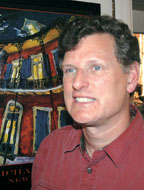|
Web Exclusives: Alumni Spotlight April 5, 2006:
Keeping jazz alive, post-Katrina
Before Hurricane Katrina, New Orleans was synonymous with jazz and the blues. Now there’s so much to be done to rebuild the city, it’s hard to know where to begin. Fielding “Chip” Lamason ’76 knows where he’s starting, though: getting the New Orleans Musicians’ Clinic, where he is director of special projects, up and running again. Before the storm, the clinic had a focused mission: addressing the dark underside of the city’s rich musical history. Louisiana has high rates of heart disease, diabetes, and cancer, and musicians face additional health risks such as deafness from loud music and depression from an often uncertain livelihood. Consider, too, that musicians have sporadic employment, income, and benefits, and you have people with ailments lacking access to care. The group, which Lamason joined in 2004, provided affordable health care and discounted medications to local musicians through two hospitals. Now those hospitals are closed, their fates uncertain, and the clinic has temporarily relocated to Lafayette, La. It is now focusing on raising emergency funds not just for medical services, but to buy instruments and assist in home repair and construction for musicians who lost their houses and possessions. A musician since the age of 8, Lamason was heavily involved in theater and music at Princeton. He played a variety of instruments and was president of Triangle Club. An anthropology major, he also developed an interest in issues of social justice, eventually earning degrees in law and environmental public policy and becoming an enforcement attorney at the U.S. Environmental Protection Agency. In 1996 he left the EPA to be a stay-at-home dad and to plunge into the traditional Appalachian music scene — fiddle-based tunes similar to bluegrass — in the Washington, D.C., area. He recorded a CD of folk chamber music. He also saw firsthand the health and socioeconomic problems facing Appalachian musicians. “In West Virginia, some of the wonderful traditional musicians were coal miners, and they had health issues arising from that,” he says. Looking for a model for a group to serve that population, he learned about the New Orleans clinic and decided to go study the group for three months. Once in New Orleans, he realized that the clinic needed fund-raising
help, and that it would be better to donate his efforts as a full-time
volunteer rather than “reinventing the wheel” back home.
He stayed — until Katrina forced his temporary relocation
to Washington, Va. The storm, however, has only strengthened his
commitment to supporting — and now rebuilding — the
city’s musical community. “Like the environment, it
is extremely difficult to assign a classical economic value to the
contribution of musicians in society,” he says. “We
are protecting a cultural asset.” By Katherine Hobson ’94 Katherine Hobson ’94 covers health and medicine at U.S. News & World Report.
|
||

